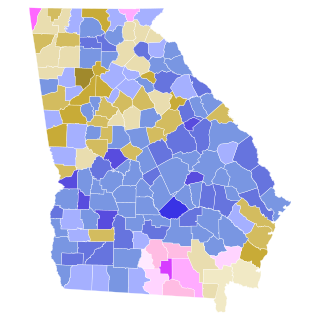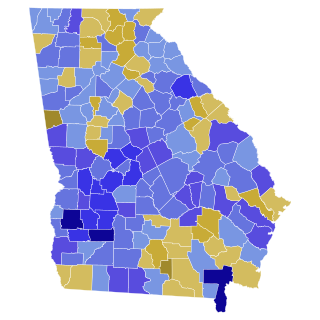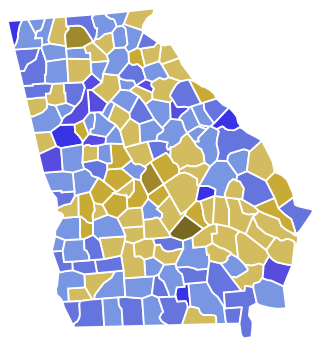
The 1948 Georgia gubernatorial special election took place on November 2, 1948, in order to elect the Governor of Georgia.
The county unit system was a voting system used by the U.S. state of Georgia to determine a victor in statewide primary elections, as well as some Congressional elections, from 1917 until 1962.

The 1956 United States Senate election in Georgia took place on November 6, 1956. Incumbent Democratic U.S. Senator Walter F. George did not run for re-election.

The 1924 United States Senate election in Georgia took place on November 4, 1924. Incumbent Democratic U.S. Senator William J. Harris was re-elected to a second term in office.

The 1954 United States Senate election in Georgia took place on November 2, 1954. Incumbent Democratic U.S. Senator Richard Russell Jr. was re-elected to a fifth term in office.

The 1960 United States Senate election in Georgia took place on November 8, 1960. Incumbent Democratic U.S. Senator Richard Russell Jr. was re-elected to a sixth term in office.

The 1946 Georgia gubernatorial election took place on November 5, 1946, in order to elect the governor of Georgia.

The 1924 Georgia gubernatorial election took place on November 4, 1924, in order to elect the governor of Georgia.

The 1926 Georgia gubernatorial election took place on November 2, 1926, in order to elect the governor of Georgia.

The 1928 Georgia gubernatorial election took place on November 6, 1928, in order to elect the governor of Georgia.

The 1930 Georgia gubernatorial election took place on November 4, 1930, in order to elect the governor of Georgia.

The 1932 Georgia gubernatorial election took place on November 8, 1932, in order to elect the governor of Georgia.

The 1934 Georgia gubernatorial election took place on November 6, 1934, in order to elect the governor of Georgia.

The 1936 Georgia gubernatorial election took place on November 3, 1936, in order to elect the governor of Georgia.

The 1938 Georgia gubernatorial election took place on November 8, 1938, in order to elect the governor of Georgia.

The 1940 Georgia gubernatorial election took place on November 5, 1940, in order to elect the governor of Georgia.

The 1942 Georgia gubernatorial election took place on November 3, 1942, in order to elect the governor of Georgia. The governor was elected to a four-year term for the first time, instead of a two-year term.

The 1944 Arkansas gubernatorial election was held on November 7, 1944.

The 1922 Arkansas gubernatorial election was held on October 3, 1922.

The 1920 Georgia gubernatorial election was held on 2 November 1920 in order to elect the Governor of Georgia. Democratic nominee and former United States Senator from Georgia Thomas W. Hardwick ran unopposed and subsequently won the election.


















